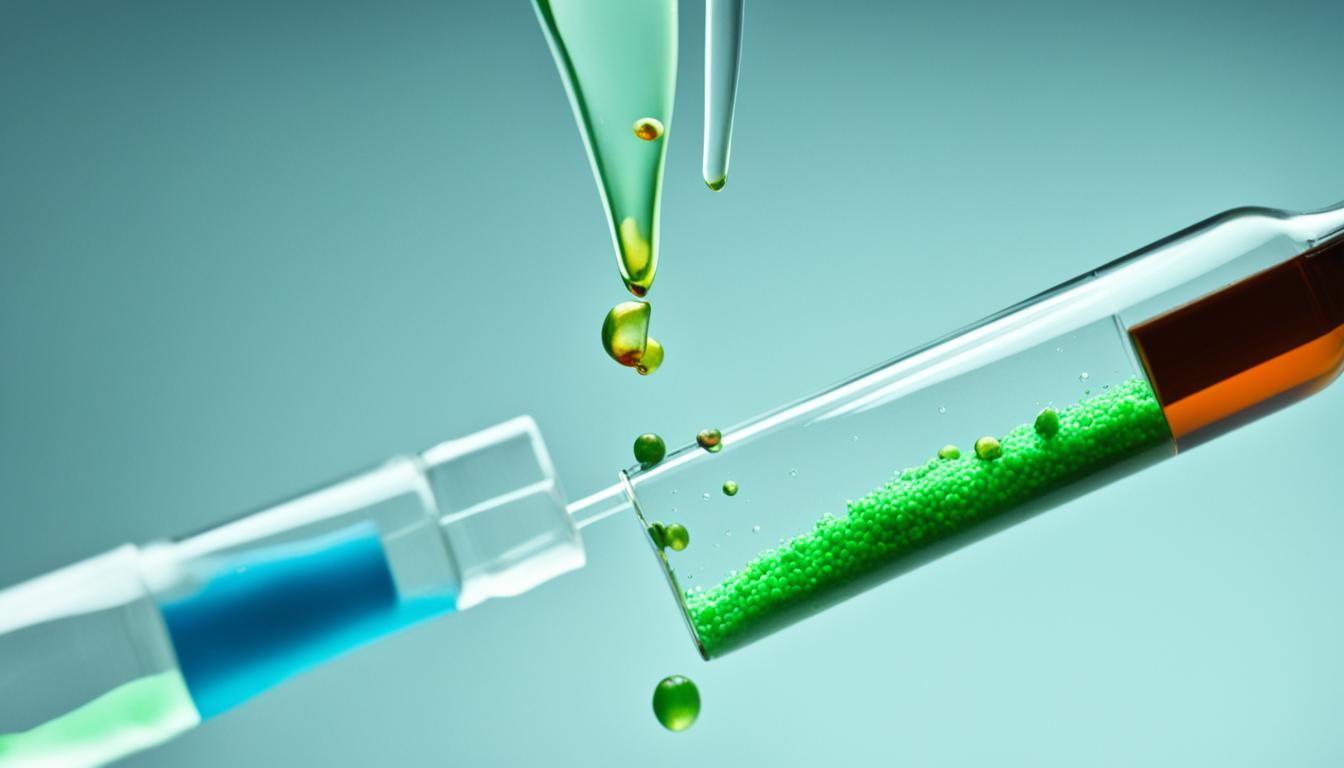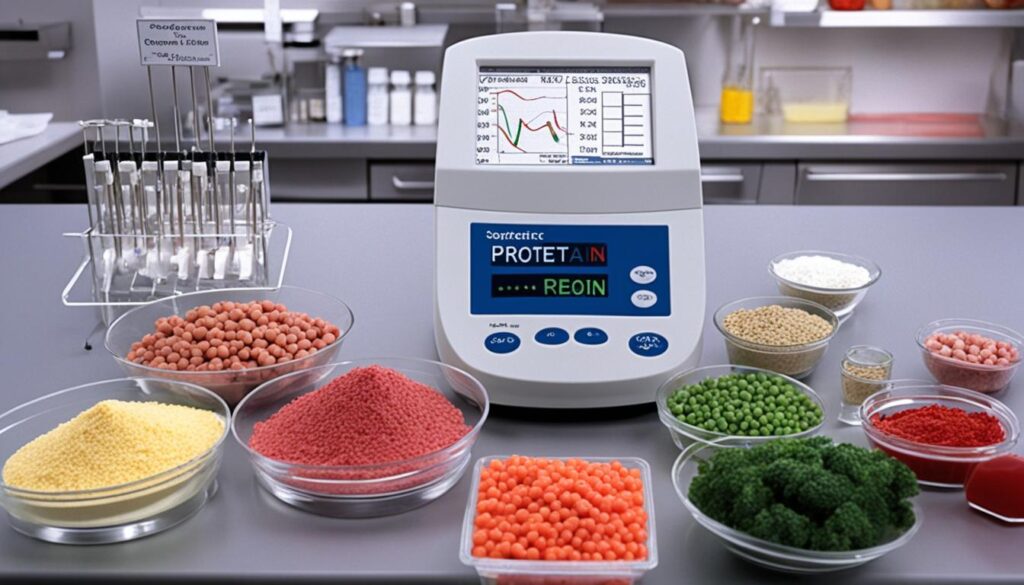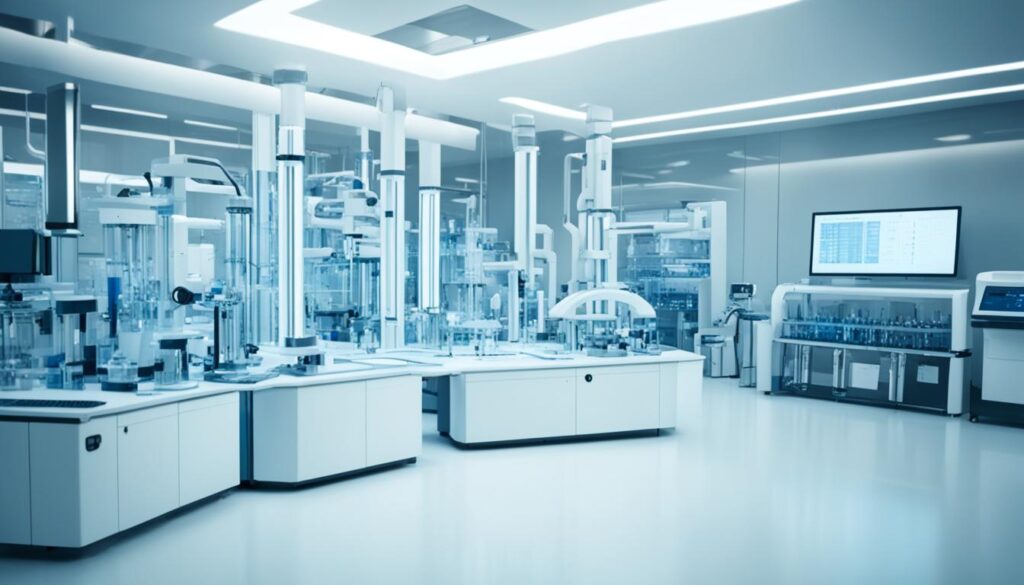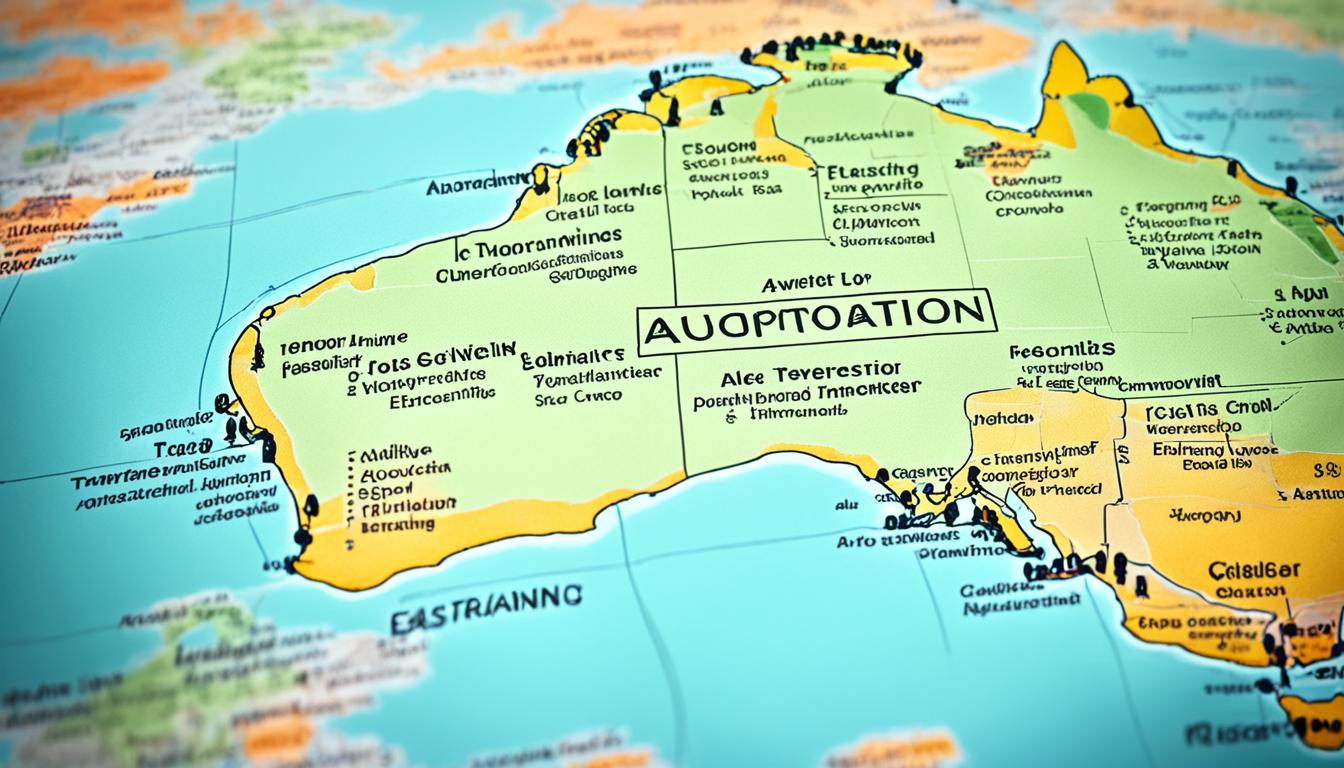
In this comprehensive guide, we will explore the various methods and techniques used to test for protein in food. By understanding these protein analysis methods, you will be able to accurately measure and quantify the protein content in different types of food.
Key Takeaways:
- Protein testing methods are essential for assessing the nutritional value and quality of food products.
- Different techniques, such as the Kjeldahl method, spectrophotometric methods, chromatographic techniques, immunological methods, and molecular biology techniques, are used for protein analysis.
- Emerging technologies, including mass spectrometry and biosensors, are advancing protein analysis capabilities in the food industry.
- Accurate protein analysis requires considering factors such as sample preparation, standardization, and validation of analytical methods.
- Protein analysis has applications in areas such as raw material assessment, process monitoring, and allergen detection in the food industry.
Importance of Protein Analysis in Food
Before we delve into the specific testing methods, it’s crucial to understand the significance of protein analysis in food. By accurately measuring protein levels in food, you can:
- Assess the nutritional value: Protein is an essential macronutrient that plays a vital role in maintaining overall health. By analyzing protein content, you can determine the nutritional composition of food and ensure that it meets the dietary requirements of individuals.
- Determine the quality of food products: Protein analysis allows you to evaluate the quality and authenticity of food products. It helps identify contaminants, adulterants, or improper manufacturing practices that can affect protein levels and compromise the safety and integrity of the food.
- Ensure compliance with labeling regulations: In many regions, food labeling regulations require accurate protein content information. Conducting protein analysis helps food manufacturers comply with these regulations and provide reliable information to consumers.
Accurate protein analysis is essential for assessing nutritional value, ensuring food quality, and complying with labeling regulations.
In the next sections, we will explore various protein analysis techniques and their applications in food testing.
| Benefits of Protein Analysis in Food | Applications |
|---|---|
| Assess nutritional value | Dietary planning |
| Determine food quality | Quality control in food manufacturing |
| Ensure compliance with labeling regulations | Food product labeling |
Factors Affecting Protein Analysis
Accurate protein analysis is influenced by several key factors, including sample preparation, interference from other compounds, and the choice of analytical method. Understanding these factors is crucial to obtain reliable and precise results.
Sample Preparation
The process of preparing the sample for protein analysis is critical in obtaining accurate results. Factors such as sample homogeneity, extraction techniques, and sample concentration can significantly impact the protein quantification process. Inadequate sample preparation can lead to biased or inconsistent protein measurements. Employing standardized sample preparation protocols and ensuring representative sampling are essential for reliable protein analysis.
Interference from Other Compounds
Interference from other compounds present in the sample can affect the accuracy of protein analysis. Compounds, such as lipids, carbohydrates, and phenolic compounds, can interfere with protein quantification, leading to overestimation or underestimation of protein levels. To mitigate these interferences, specific extraction methods or purification steps may be required to remove or reduce the presence of interfering substances.
Choice of Analytical Method
The selection of the appropriate analytical method is crucial for reliable protein analysis. Different methods, such as spectrophotometric assays, chromatographic techniques, immunological methods, and molecular biology techniques, offer various advantages and limitations. Factors such as sensitivity, specificity, cost, and sample compatibility should be considered when choosing the most suitable method for protein quantification in a particular food matrix.
Table: Factors Affecting Protein Analysis
| Factors | Description |
|---|---|
| Sample Preparation | The process of preparing the sample for analysis, including homogeneity and extraction techniques. |
| Interference from Other Compounds | The presence of compounds in the sample that can interfere with protein quantification. |
| Choice of Analytical Method | The selection of the most suitable analytical method for protein quantification. |
The understanding and management of these factors significantly contribute to the accuracy and reliability of protein analysis in different food matrices. By carefully considering sample preparation techniques, minimizing interference from other compounds, and selecting the appropriate analytical method, researchers and food industry professionals can ensure more precise measurements of protein content in food products.
The Kjeldahl Method
The Kjeldahl method is a widely recognized and essential protein testing method in the field of food analysis. This technique allows for accurate determination of protein content by converting the nitrogen within the sample to ammonia, which is then quantified. The Kjeldahl method involves distinct steps, including digestion and distillation, to measure protein levels in food.
Let us explore the step-by-step procedure of the Kjeldahl method:
- Sample Preparation: Begin by accurately weighing a representative sample of the food product. It is crucial to ensure that the sample is homogenous and representative to obtain reliable results.
- Digestion: Transfer the sample to a digestion flask and add sulfuric acid along with a digestion catalyst, typically potassium sulfate or copper sulfate. Heat the mixture in a controlled environment to facilitate the degradation of proteins and convert nitrogen to ammonium sulfate.
- Distillation: After digestion, the ammonia liberated during the process needs to be distilled. Place the digestion flask in a distillation apparatus, where the ammonia is released by adding sodium hydroxide and collected in a receiving flask containing an acid solution.
- Titration: The amount of ammonia collected in the receiving flask is determined by titration with a standardized acid solution. This allows for the calculation of nitrogen content, which can then be used to calculate the protein content.
The Kjeldahl method offers several advantages, such as its versatility and ability to measure total protein content. It is widely employed in food analysis laboratories due to its proven accuracy and reliability. However, it is essential to consider certain limitations of this method, including its time-consuming nature and the potential for interference from non-protein nitrogen compounds.
Advantages of the Kjeldahl Method:
The Kjeldahl method is advantageous for protein testing in food due to:
- Comprehensive analysis: Measures total protein content encompassing all protein types.
- Accuracy: Offers reliable and precise results when performed correctly.
- Industry acceptance: Widely recognized and accepted by regulatory authorities.
Limitations of the Kjeldahl Method:
Despite its popularity, the Kjeldahl method has a few limitations:
- Time-consuming: The process involves multiple steps, making it time-consuming.
- Non-protein nitrogen interference: Non-protein nitrogen compounds may interfere with protein content determination.
- Cost: Requires specialized equipment and reagents, increasing overall analysis costs.
By employing the Kjeldahl method, food analysts can obtain reliable protein content data, aiding in accurate nutritional labeling and quality control measures across various food products.
| Advantages of the Kjeldahl Method | Limitations of the Kjeldahl Method |
|---|---|
| Comprehensive analysis: Measures total protein content encompassing all protein types. | Time-consuming: The process involves multiple steps, making it time-consuming. |
| Accuracy: Offers reliable and precise results when performed correctly. | Non-protein nitrogen interference: Non-protein nitrogen compounds may interfere with protein content determination. |
| Industry acceptance: Widely recognized and accepted by regulatory authorities. | Cost: Requires specialized equipment and reagents, increasing overall analysis costs. |
Spectrophotometric Methods
Spectrophotometric methods are widely used in protein testing and offer a reliable way to measure protein levels in food. Two commonly employed techniques are the Bradford assay and the Biuret method. Both methods rely on the interaction of proteins with specific dyes or reagents to quantify protein content.
The Bradford assay utilizes the principle of protein binding with Coomassie Brilliant Blue G-250 dye. The dye undergoes a color change when bound to proteins, and the intensity of the color can be measured spectrophotometrically. This method is widely used due to its simplicity, sensitivity, and broad applicability.
The Biuret method is based on the formation of a purple complex when proteins react with copper ions in an alkaline medium. The intensity of the color produced is directly proportional to the protein concentration and can be measured using a spectrophotometer. This method is commonly used for routine protein analysis.
Both the Bradford assay and the Biuret method have their advantages and limitations. The choice of method depends on factors such as the protein sample characteristics, the required sensitivity, and the available resources.
Here is a comparison of the Bradford assay and Biuret method:
| Parameter | Bradford Assay | Biuret Method |
|---|---|---|
| Principle | Dye binding to proteins | Formation of a color complex with copper ions |
| Sensitivity | High | Moderate |
| Applicability | Wide range of protein types | General protein analysis |
| Interference | Substances that absorb at the same wavelength as the dye | Interference by reducing agents or other compounds |
| Sample Requirements | Pure protein extract | Protein sample without interfering substances |
Applications
These spectrophotometric methods are widely applied in various industries, including food manufacturing, research, and quality control. Measuring protein levels in food is crucial for nutritional labeling, allergen detection, and process optimization. The Bradford assay and Biuret method find applications in:
- Nutritional analysis of food products
- Quality control in food manufacturing
- Allergen testing
- Protein engineering and research
These methods provide valuable insights into the protein content of food, enabling accurate formulation, labeling, and assessment of nutritional value.

Chromatographic Techniques
When it comes to protein analysis techniques, chromatographic methods such as high-performance liquid chromatography (HPLC) and gas chromatography (GC) are widely employed. These techniques offer precise separation and quantification of proteins, making them invaluable tools in the field of food protein analysis.
HPLC utilizes a stationary phase and a mobile phase, allowing for the separation of proteins based on their molecular properties such as size, charge, and hydrophobicity. This technique enables the accurate quantification of individual proteins within complex mixtures, providing valuable information about their distribution and concentration.
GC, on the other hand, utilizes a gaseous mobile phase and a solid stationary phase to separate proteins based on their volatility. By measuring the retention times of different protein components, GC allows for the identification and quantification of proteins in a sample.
Both HPLC and GC offer several advantages in protein analysis. They provide high resolution, sensitivity, and reproducibility, allowing for the detection of even trace amounts of proteins. Moreover, these techniques can be coupled with various detectors, such as mass spectrometry, to enhance their capabilities in protein identification and characterization.
“Chromatographic techniques, such as HPLC and GC, are essential tools for protein analysis in the food industry. They enable accurate separation and quantification of proteins, providing valuable insights into the composition and quality of food products.”
In food protein analysis, chromatographic techniques find applications in various areas, including allergen detection, quality control, and authentication. By precisely quantifying the protein content and detecting potential contaminants or adulterants, these techniques contribute to ensuring the safety and authenticity of food products.
| Advantages of Chromatographic Techniques in Protein Analysis | Applications of Chromatographic Techniques in Food Industry |
|---|---|
|
|
Immunological Methods
When it comes to protein detection in food, immunological methods are invaluable. These techniques rely on specific antigen-antibody reactions to accurately detect and quantify proteins. Two commonly used immunological methods in food protein analysis are the enzyme-linked immunosorbent assay (ELISA) and lateral flow assays.
ELISA:
The enzyme-linked immunosorbent assay (ELISA) is a robust and widely employed technique for protein analysis. It involves the immobilization of a specific antibody on a solid surface, such as a microtiter plate. The sample containing the protein of interest is added, and if the protein is present, it binds to the immobilized antibody. Through a series of washing steps, any unbound substances are removed. Finally, a secondary antibody linked to an enzyme is added, which allows the detection and quantification of the protein of interest.
Lateral Flow Assays:
Lateral flow assays offer a rapid and user-friendly method for protein detection. They consist of a strip that contains different zones, including a sample application pad, a conjugate release pad, a test line containing immobilized antibodies, and a control line. The sample is applied to the sample pad, and the fluid migrates along the strip. If the protein of interest is present in the sample, it binds to the immobilized antibodies at the test line, resulting in a visible signal (such as a color change) that indicates a positive result.
Applications in Food Protein Analysis
Immunological methods have various applications in the food industry, allowing for the accurate detection and quantification of proteins. These methods can be used to:
- Confirm the presence or absence of specific proteins in food products
- Detect allergenic proteins that may cause adverse reactions in susceptible individuals
- Monitor food quality and assess potential contaminants
- Verify the accuracy of food labeling claims regarding protein content
| Immunological Method | Advantages | Limitations |
|---|---|---|
| ELISA | – High sensitivity and specificity – Quantitative results – Wide range of applications |
– Requires specialized equipment and reagents – Time-consuming procedure |
| Lateral Flow Assays | – Rapid and user-friendly – No specialized equipment required – Visual interpretation of results |
– Lower sensitivity compared to ELISA – Limited capacity for quantitative analysis |
Immunological methods offer precise and reliable protein analysis in the food industry. Their ability to selectively detect and quantify proteins provides invaluable insights into food quality, safety, and labeling compliance.
Molecular Biology Techniques
Molecular biology techniques, such as polymerase chain reaction (PCR) and nucleic acid-based protein detection methods, play a crucial role in protein quantification and testing protein content in food. These advanced methods offer sensitive and specific analysis, enabling precise measurements in different food matrices.
PCR for Protein Quantification
PCR is widely used in molecular biology research and has proven to be a valuable tool in quantifying protein content. This technique amplifies specific DNA sequences that are associated with protein coding genes. By measuring the amount of amplified DNA, protein levels can be estimated.
| Advantages of PCR for Protein Quantification | Limitations of PCR for Protein Quantification |
|---|---|
| – High sensitivity | – Indirect measurement of protein levels |
| – Specificity for target proteins | – Requires prior knowledge of target gene sequence |
| – Wide dynamic range | – Inability to differentiate between active and inactive proteins |
Nucleic Acid-Based Protein Detection
Nucleic acid-based methods provide direct detection and quantification of specific proteins through the analysis of RNA or DNA sequences. These techniques target the nucleic acid molecules that are unique to the proteins of interest, allowing precise determination of their levels in food samples.
One such method is the Northern blotting technique, which involves the separation and detection of RNA molecules.
“By employing nucleic acid-based techniques, researchers can accurately measure protein content in food samples and gain insights into their nutritional composition.”
Comparison of Molecular Biology Techniques
| Technique | Advantages | Limitations |
|---|---|---|
| PCR | – High sensitivity – Specificity for target proteins – Wide dynamic range |
– Indirect measurement of protein levels – Requires prior knowledge of target gene sequence – Inability to differentiate between active and inactive proteins |
| Nucleic Acid-Based Detection | – Direct detection and quantification – Specific targeting of proteins – Allows insights into nutritional composition |
– Technique-dependent variations – Cost and time intensiveness |
Molecular biology techniques provide valuable tools for testing protein content in food. By harnessing the power of PCR and nucleic acid-based detection methods, researchers and food industry professionals can ensure accurate protein quantification in various food matrices.
Emerging Technologies for Protein Analysis
As the field of protein analysis continues to evolve, new technologies are revolutionizing the way we test and measure protein in food. These emerging techniques offer enhanced sensitivity, accuracy, and efficiency, opening up new possibilities for food protein testing procedures. Two notable technologies that are gaining prominence in protein analysis are mass spectrometry and biosensors.
Mass Spectrometry
Mass spectrometry has emerged as a powerful protein analysis technique, providing precise identification and quantification of proteins in complex food matrices. This technique involves ionizing protein molecules and separating them based on their mass-to-charge ratio. By analyzing the resulting mass spectra, researchers can determine the molecular weight and structural information of proteins with remarkable accuracy.
Mass spectrometry enables the detection of proteins at extremely low levels, making it ideal for identifying allergens and contaminants in food products.
Moreover, mass spectrometry offers unparalleled versatility, allowing for the analysis of various protein modifications and interactions. It has become an indispensable tool in proteomics research and is increasingly being adopted for food protein analysis in research laboratories and industry settings.
Biosensors
Biosensors are innovative devices that utilize biological molecules to detect and measure specific proteins in food samples. These devices combine the recognition capability of biological receptors, such as antibodies or enzymes, with transducers to convert the protein-probe interaction into a measurable signal. This enables the real-time monitoring of protein levels in food products.
A key advantage of biosensors is their portability and ease of use, which makes them well-suited for on-site protein analysis in food processing facilities. They offer rapid results, require minimal sample preparation, and can be integrated into automated systems for high-throughput analysis.
Biosensors provide a cost-effective and efficient solution for routine protein testing, enabling the food industry to ensure product quality and safety.
The Future of Protein Analysis
The integration of mass spectrometry and biosensors with other advanced technologies, such as nanotechnology and artificial intelligence, holds tremendous potential for the future of protein analysis. These synergistic approaches can further enhance the sensitivity, specificity, and speed of protein detection and quantification, paving the way for a new era of food protein testing procedures.
By harnessing the power of these emerging technologies, researchers and food industry professionals can gain deeper insights into the composition, functionality, and safety of protein-based food products.
Stay tuned for the next section as we delve into considerations for accurate protein analysis.

| Technology | Advantages | Limitations |
|---|---|---|
| Mass Spectrometry |
|
|
| Biosensors |
|
|
Considerations for Accurate Protein Analysis
When conducting protein analysis, it is paramount to consider several key factors to ensure the accuracy and reliability of your results. By paying attention to sample homogeneity, appropriate standardization, and validation of analytical methods, you can enhance the quality of your protein testing process and achieve more precise outcomes.
Sample Homogeneity
One crucial factor in protein analysis is the homogeneity of your food samples. Uneven distribution of proteins in a sample can lead to inconsistent results. To improve sample homogeneity:
- Thoroughly mix and homogenize your samples to ensure an even distribution of proteins.
- Consider using representative subsamples to account for any spatial variations in protein content.
Appropriate Standardization
Standardization is essential for accurate protein analysis. By employing appropriate standards, you can calibrate your instruments, validate your results, and ensure consistent measurements. When using standards:
- Select standards that closely resemble the protein composition of your food samples.
- Prepare your standards following established protocols and guidelines.
- Regularly check the validity and reliability of your standards to detect any potential variations.
Validation of Analytical Methods
Validating the selected analytical methods is crucial to ensure the reliability and accuracy of protein analysis. To validate your methods:
- Compare the results obtained from different protein testing methods to confirm consistency.
- Perform method validation studies using known protein standards to assess the precision, accuracy, and linearity of your chosen methods.
| Considerations for Accurate Protein Analysis | Actions |
|---|---|
| Sample Homogeneity | Thoroughly mix and homogenize samples Use representative subsamples |
| Appropriate Standardization | Select similar standards Prepare standards following protocols Regularly check the validity of standards |
| Validation of Analytical Methods | Compare results from different methods Perform method validation studies |
By implementing these considerations in your protein testing methods, you can improve the accuracy and reliability of your results, enabling you to make informed decisions regarding protein detection in food.
Challenges and Limitations of Protein Analysis
Despite the remarkable advancements in protein analysis techniques, it’s important to acknowledge the challenges and limitations that can impact the accuracy and reliability of results. Various factors, including sensitivity, specificity, and matrix interference, play a significant role in protein analysis. Let’s explore these challenges in detail:
Sensitivity:
One of the primary challenges in protein analysis is achieving a sufficient level of sensitivity to detect and quantify proteins accurately. Some proteins may be present in low concentrations, requiring specialized techniques to overcome detection limits and ensure reliable analysis.
Specificity:
The specificity of protein analysis refers to its ability to accurately identify and quantify target proteins without interference from other compounds or substances present in the sample. Achieving high specificity is crucial for obtaining precise results and avoiding false positives or false negatives.
Matrix Interference:
The complex composition of food matrices can pose challenges in protein analysis. Certain components in food samples, such as fats, carbohydrates, and minerals, can interfere with protein detection or affect the accuracy of quantification. Overcoming matrix interference requires careful sample preparation and method selection.
“Accurate protein analysis requires overcoming challenges related to sensitivity, specificity, and matrix interference.”
Despite these challenges, scientists and researchers continually strive to develop innovative protein analysis techniques that address these limitations and improve accuracy in detecting and quantifying proteins in various food samples.
Challenges of Protein Analysis
| Challenges | Impact |
|---|---|
| Sensitivity | Difficulty in detecting proteins at low concentrations |
| Specificity | Potential for false positives or false negatives |
| Matrix Interference | Interference from other food components affecting accuracy |
Understanding and addressing these challenges are critical for accurate protein analysis and ensuring the reliability of results in different food samples.
Applications of Protein Analysis in Food Industry
Protein analysis techniques are invaluable for maintaining quality control and driving product development in the food industry. By accurately measuring protein levels in food, various aspects of the production process can be assessed and optimized. Let’s explore some of the key applications of protein analysis in the food industry:
1. Raw Material Assessment
The protein content of raw materials used in food production can have a significant impact on the quality of the final product. Protein analysis enables manufacturers to assess the protein levels in ingredients such as grains, meat, dairy, and plant-based alternatives. This information helps ensure the consistency and nutritional value of the food products.
2. Process Monitoring
During food processing, protein analysis techniques allow for real-time monitoring of protein changes and transformations. By analyzing protein levels at different stages of the production process, manufacturers can identify any deviations that may impact the overall quality or functionality of the food product. This helps maintain consistency and ensures adherence to desired specifications.
3. Allergen Detection
Protein analysis plays a critical role in detecting allergens in food products. By employing specialized techniques, such as enzyme-linked immunosorbent assay (ELISA), manufacturers can detect and quantify the presence of allergenic proteins, ensuring compliance with labeling regulations and protecting consumers with food allergies.
By utilizing protein analysis techniques, the food industry can enhance product quality, meet regulatory requirements, and address consumer demands for transparency and safety. Accurate measurement of protein levels in food enables manufacturers to make informed decisions throughout the production process, ultimately delivering high-quality, nutritious, and allergen-free food products.
| Applications of Protein Analysis in Food Industry |
|---|
| Raw Material Assessment |
| Process Monitoring |
| Allergen Detection |
Best Practices for Protein Analysis
To ensure accurate and reliable protein analysis, it is important to follow the best practices outlined below. These guidelines cover essential aspects such as sample handling, method selection, data interpretation, and quality assurance.
Sample Handling
- Ensure proper sample preparation techniques to maintain sample integrity.
- Follow standardized procedures for sample collection, storage, and transportation.
- Avoid sample contamination by using appropriate sterilization techniques and clean equipment.
Method Selection
- Choose protein quantification methods that are suitable for the specific food matrix being analyzed.
- Consider factors such as sensitivity, specificity, cost, and time requirements when selecting the appropriate method.
- Validate the chosen method to ensure its accuracy and reliability in measuring protein content.
Data Interpretation
- Accurately record and document all data obtained during the analysis process.
- Use appropriate statistical analysis techniques when interpreting the results.
- Consider the limitations and uncertainties associated with each method and factor them into the data interpretation.
Quality Assurance
- Implement quality control procedures to ensure the reliability and reproducibility of the analysis.
- Regularly calibrate and maintain analytical equipment to guarantee accurate measurements.
- Participate in proficiency testing programs to verify the laboratory’s analytical performance.
“Following these best practices will help you obtain reliable protein analysis results, allowing you to make informed decisions regarding food quality, labeling, and nutritional composition.”
By adhering to these guidelines, you can ensure the accuracy and reliability of your protein analysis, enabling you to meet regulatory requirements and deliver high-quality food products.
Comparison of Protein Analysis Methods
| Method | Principle | Advantages | Limitations |
|---|---|---|---|
| Kjeldahl Method | Digestion and distillation | – Widely accepted and validated – Measures total nitrogen content |
– Time-consuming – Requires specialized equipment – Does not provide specific protein identification |
| Spectrophotometric Methods | Interaction with specific dyes or reagents | – Rapid analysis – Quantifies protein content in a wide range |
– Relies on accurate dye-protein interaction – May be affected by interferences from other compounds |
| Chromatographic Techniques | Precise separation and quantification | – High sensitivity and specificity – Enables protein identification |
– Requires complex instrumentation – Longer analysis time |
| Immunological Methods | Antigen-antibody reactions | – Specific detection of target proteins – High sensitivity |
– Requires antibody specificity validation – May be affected by cross-reactivity |
| Molecular Biology Techniques | Nucleic acid-based detection methods | – High sensitivity and specificity – Can detect low-abundance proteins |
– Requires DNA/RNA extraction steps – Requires specialized equipment |
| Mass Spectrometry | Ionization and mass analysis | – Accurate protein identification – High sensitivity for low-abundance proteins |
– Requires advanced instrumentation and expertise – Time-consuming data analysis |
Conclusion
In conclusion, understanding and implementing proper protein analysis techniques are essential for obtaining accurate nutritional insights and ensuring the quality and safety of food products. By following the methods and guidelines provided in this guide, you can confidently test for protein in food and make informed dietary choices.
Protein analysis plays a vital role in assessing the nutritional value of food, determining product quality, and complying with labeling regulations. Whether you choose the Kjeldahl method, spectrophotometric methods, chromatographic techniques, immunological methods, molecular biology techniques, or emerging technologies, each method has its advantages and applications.
It is important to consider factors such as sample preparation, interference from other compounds, and the choice of analytical method to obtain reliable and precise results. Additionally, practicing best practices, such as sample homogeneity, appropriate standardization, and validation of analytical methods, will enhance the accuracy and confidence of your protein analysis.







